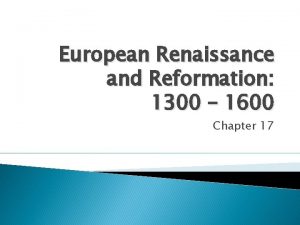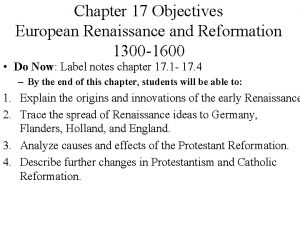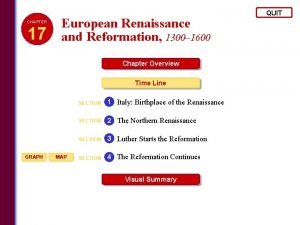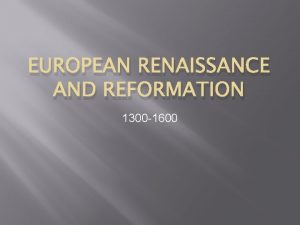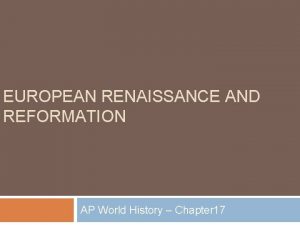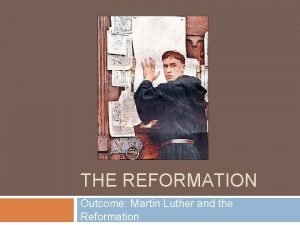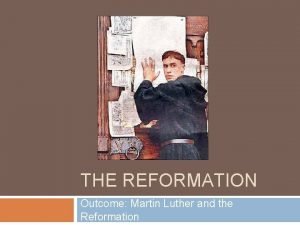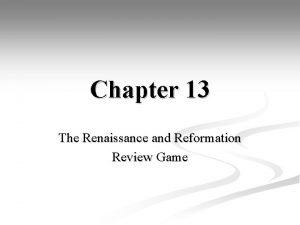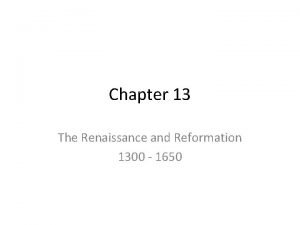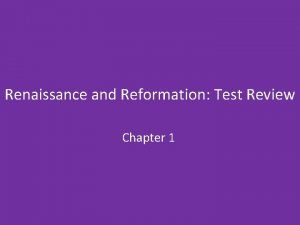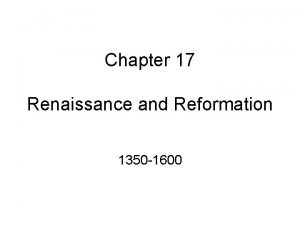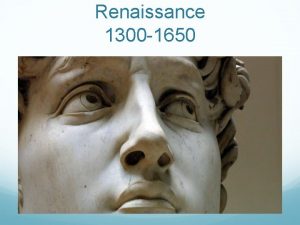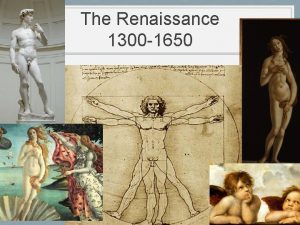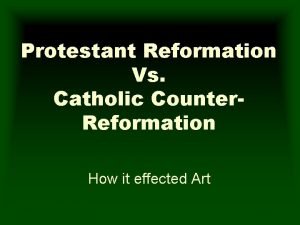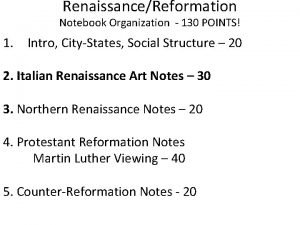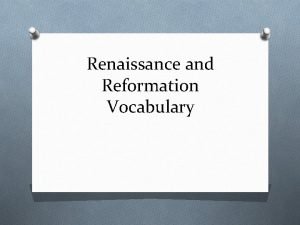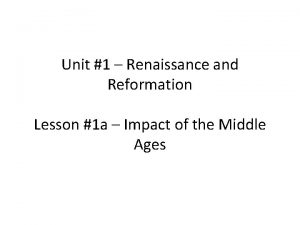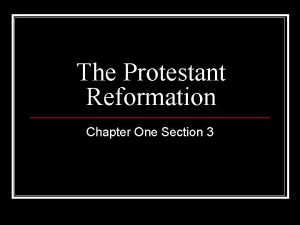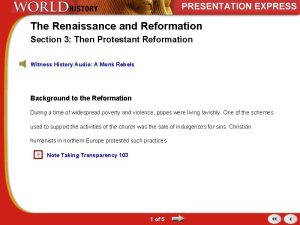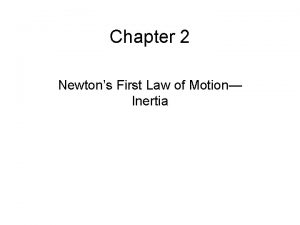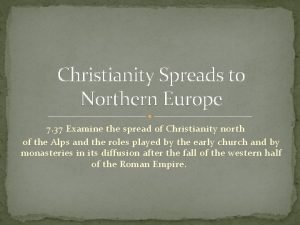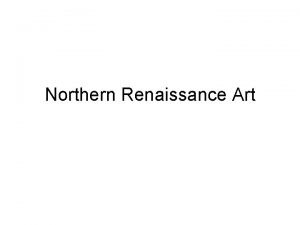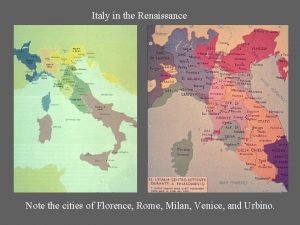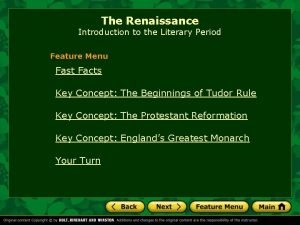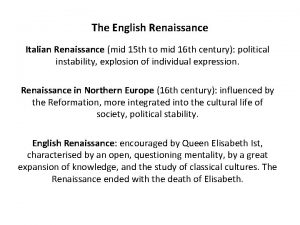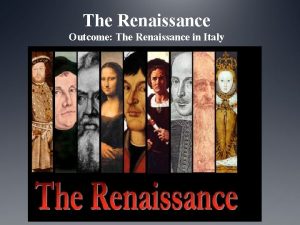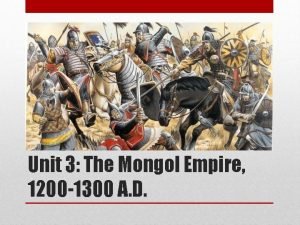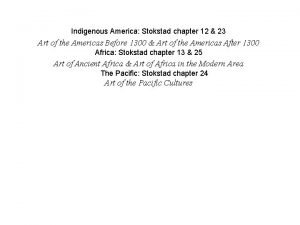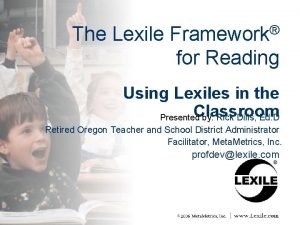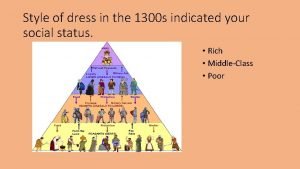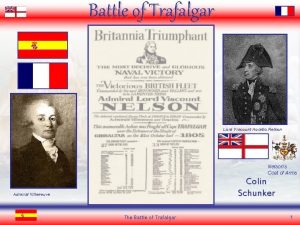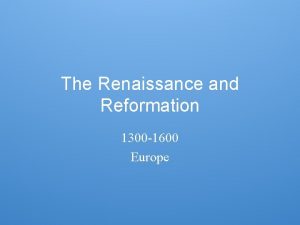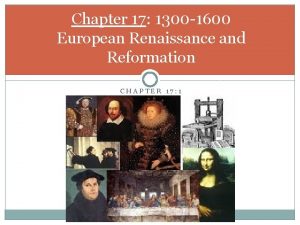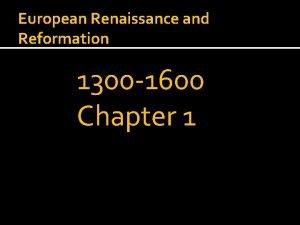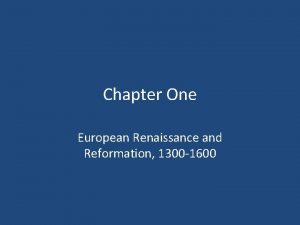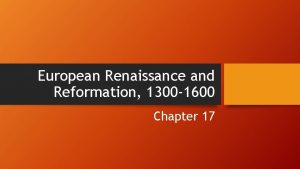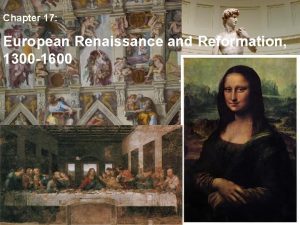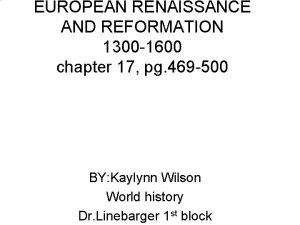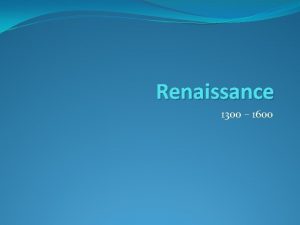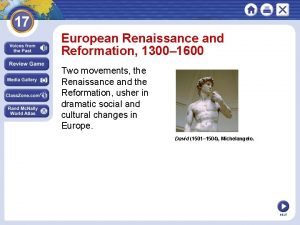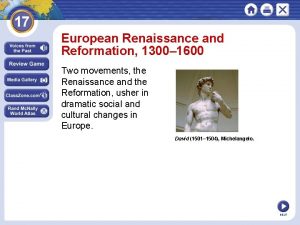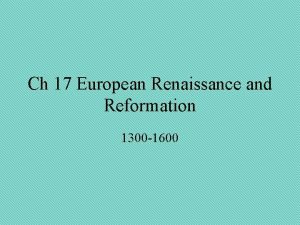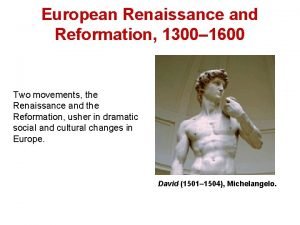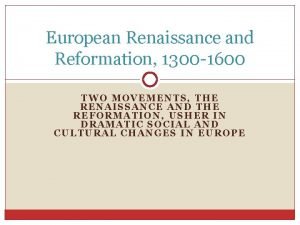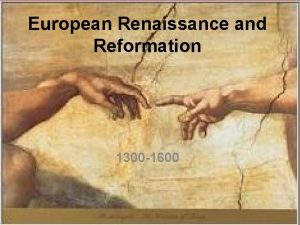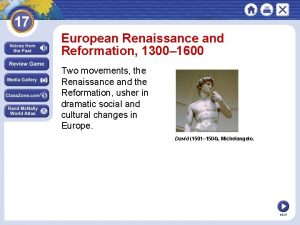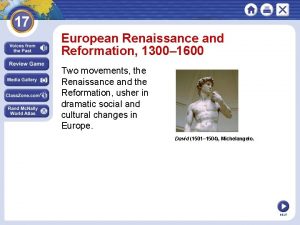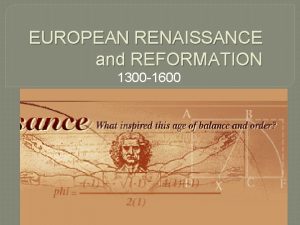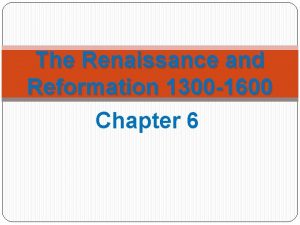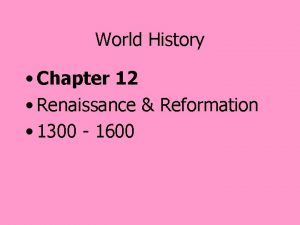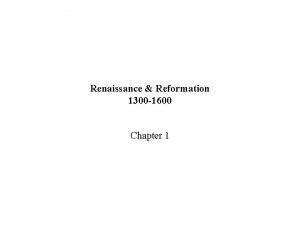Chapter 17 European Renaissance and Reformation 1300 1600







































- Slides: 39

Chapter 17 European Renaissance and Reformation 1300 -1600 Section 1 Italy: Birthplace of the Renaissance

Homework Alert Read Chapter 17 Section 1 **There will be a reading comprehension quiz tomorrow in class. **

An Age of Questions �During the late Middle Ages, Europeans suffered from war and plague �People began to question the Church and the structure of medieval society �People wanted to celebrate life and the human spirit �People looked at classical past for ideas Crash Course on the Renaissance

The Birthplace of the Renaissance � Renaissance (1300 -1600) � Explosion of creativity in Europe � Art, writing, and thought � “rebirth” – a rebirth of art and learning � Educated people hoped to bring back to life the cultures of Ancient Greece and Rome � The Renaissance began in Italy and spread north � Hit England France later because they were suffering from the Hundred Years’ War

Italy’s Advantages �Italy had 3 advantages that fostered the Renaissance: �cities and urban centers �wealthy merchant class �classical heritage

Cities and Urban Centers �Overseas trade started during the Crusades and led to the growth of large cities in Italy �As a result, Italy was urban while the rest of Europe was still mostly rural. �The plague allowed people to pursue new interests, such as art �The plague also caused a shortage of workers and allowed the survivors to expand their businesses

Wealthy Merchant Class �In Italian cities, merchants were the wealthiest and most powerful class, dominating politics �Becoming wealthy was based on achievements, not heritage �Ex. Florence’s Medici Family �Traders and bankers �Ruled Florence for years as dictators but gave the appearance of an elected government �Supported the arts

Classical Heritage �The Renaissance brought a desire to return to the teachings of ancient Greece and Rome �Many scholars studied Latin and studied Latin manuscripts that were preserved in monasteries.

Classical and Worldly Values �The study of classical works led to new ideas and values in Europe �Humanism �An intellectual movement that focused on human potential and achievements �Study of humanities = history, literature, and philosophy

Classical and Worldly Values �Enjoyment of life �One can enjoy life without offending God �The wealthy lived more luxuriously �Most people remained Catholic but the spirit of Renaissance society was secular, or worldly, rather than spiritual, and concerned with the here and now �Patrons of the Arts �People looked to beautify Rome �Patrons of the arts financially supported artists

Classical and Worldly Values �The Renaissance Man �The ideal individual strove to master almost every area of study �A man who excelled in many fields was praised as a “universal man” or a “Renaissance man” �Baldassare Castiglione wrote The Courtier, that taught how to become an Renaissance man. � Charming and witty � Well educated on classics � Dance, sing, play music, and write poetry � Skilled rider, wrestler, and swordsman

Classical and Worldly Values �Renaissance Women �Also addressed in The Courtier �Expected to know the classics and be charming, yet not expected to seek fame �Inspire art but rarely create it �Much better educated than women of the Middle Ages, but had little influence in politics

Classwork Alert Read “Analyzing Primary Documents” on page 473. Answer Document-Based Questions 1 and 2 In your notebook, copy down all terms and definitions in Sections 1 and 2. Page 477 Answer #s 2 -6

The Renaissance Revolutionized Art �As the Renaissance advanced, artistic styles changed. �Renaissance artists portrayed religious subjects, but they used a realistic style. �More realistic sculptures with natural postures and expressions � Ex. Donatello’s David �Roman painters used the technique of perspective, which shows three dimensions on a flat surface �Emphasis on individual led to portraits of prominent citizens

Perspective Marriage of the Virgin (1504) Raphael

Perspective School of Athens (1508) Raphael

Leonardo da Vinci �A true “Renaissance man” �Painter, sculptor, inventor, and scientist �Interested in how things worked � How muscles moved �The Mona Lisa and The Last Supper studied the human body

Mona Lisa (1503 -1506) Leonardo da Vinci

The Last Supper, (1494 -1498) Leonardo da Vinci

The da Vinci Notebooks

Homework Alert! Write a 2 page compare and contrast essay: 1. Research a “Renaissance man” from the 1300 -1500 s. (Cannot be Leonardo da Vinci or Michelangelo) 2. Think of and research a contemporary “Renaissance man” from 2015. (ex. Bill Gates, Oprah, Donald Trump, etc. ) 3. After researching both people, write a compare and contrast essay: • Tell me why each of these people can be considered “Renaissance men. /women”. What have they done to earn this title? • What attributes did a person need to have in the 1300 -1500 s to be considered a “Renaissance man”? • What attributes does a person need to have today in order to be considered a “Renaissance man/woman”?

Renaissance Writers Change Literature �Some writers continued to write in the vernacular, or the everyday language of an area �Wrote for self-expression �Niccolo Machiavelli wrote “The Prince” as an examination of the imperfection of human beings �“The Prince” examines how a ruler can gain power and keep it in spite of his enemies

Chapter 17 European Renaissance and Reformation 1300 -1600 Section 2 The Northern Renaissance

Homework Alert Read Chapter 17 Section 2 **There will be a reading comprehension quiz tomorrow in class. **

The Northern Renaissance �By late 1400 s Renaissance ideas has spread to Northern Europe, especially England, France, Germany, and Flanders (now part of France and the Netherlands) �After the Hundred Years’ War cities in England France grew rapidly. �Merchants became wealthy and sponsored artists. �Due to northern traditions that were different from those in Italy, the Northern Renaissance developed its own

Artistic Ideas Spread �As Italian artists traveled north and as Northern European artists studied in Italy, the styles and techniques of the Italian Renaissance spread. �German artists Albrecht Durer �Studied in Italy �Religious subjects, classical myths, landscapes �Emphasis on realism

The Great Piece of Turf (1503) Albrecht Durer

Virgin and Child Before Archway (1495) Albrecht Durer

Artistic Ideas Spread �Flemish Renaissance painter – Jan van Eyck �Used new medium of oilbased paints to develop techniques that painters still use �Realistic details and personality of subjects

The Virgin of Chancellor Rolin (1435) Jan van Eyck

Arnolfini Wedding Portrait (1434) Jan van Eyck

Northern Writers Try to Reform Society �Northern humanists used Renaissance ideas to examine the traditional teachings of the Church. �Critical of the failure of the Christian Church to get people to live a Christian life �Started a movement called Christian humanism � Goal was to reform society and educate

Northern Writers Try to Reform Society �Desiderius Erasmus and Thomas More– Christian humanists �Erasmus – The Praise of Folly – poked fun a greedy merchants, quarrelsome scholar and pompous priests �More- Utopia – a better model of society where greed, corruption, and war have been weeded out � Utopia place – “no place”; and ideal

Classwork Alert 1. Read “Analyzing Art” on page 481 Answer “Skill Builder” Question 2. Answer “Man Ideas” #3 on page 485 3. Read “City Life in Renaissance Europe” on page 486487 Answer “Connect to Today” Questions #1 and 2

The Elizabethan Age �The Renaissance spread to England in the mid 1500 s �The period was known as the Elizabethan Age �Queen Elizabeth I reigned from 1558 -1603 �“Renaissance woman”: spoke 4 languages, ruled as Queen of England, poet, wrote music, and was a patron of the arts

The Elizabethan Age �The most famous writer of the Elizabethan Age was William Shakespeare �Wrote poems and plays that were performed at the Globe Theater in London �Drew on the classics for inspiration and plots �Showed deep understanding of human beings and examined human flaws �Tragedies: Macbeth, Hamlet, Romeo and Juliet �Comedies: A Midsummer’s Night Dream, The Taming of the Shrew

Printing Spreads Renaissance Ideas �Johann Gutenberg reinvented the Chinese moveable type in 1440 �printing press – a machine that presses paper against a tray full of inked moveable type �Made the process of printing books quicker and cheaper �Gutenberg printed a complete Bible, The Gutenberg Bible in 1455

Printing Spreads Renaissance Ideas �The printing press had a significant impact on European society �Able to print many more books in a short amount of time �Made books cheaper so the average person could buy them �New ideas spread more quickly � Religious books as well as many other subjects of the Renaissance

Printing Spreads Renaissance Ideas �The printing press had a significant impact on European society (continued) �Encouraged people to read � Literacy rates rose �Authors continued to write in the vernacular so that the average person could read � Printed the Bible in the vernacular so people could better understand scripture � This leads to reform in the Church
 The renaissance rebirth
The renaissance rebirth Chapter 17 european renaissance and reformation
Chapter 17 european renaissance and reformation European renaissance and reformation chapter 17
European renaissance and reformation chapter 17 European renaissance and reformation chapter 17
European renaissance and reformation chapter 17 Who wrote praise of folly
Who wrote praise of folly European renaissance and reformation answer key
European renaissance and reformation answer key The reformation outcome martin luther and the reformation
The reformation outcome martin luther and the reformation The reformation outcome martin luther and the reformation
The reformation outcome martin luther and the reformation Chapter 13 the renaissance and reformation
Chapter 13 the renaissance and reformation Chapter 13 renaissance and reformation
Chapter 13 renaissance and reformation Renaissance and reformation test review
Renaissance and reformation test review Chapter 12 renaissance and reformation worksheet answer key
Chapter 12 renaissance and reformation worksheet answer key Chapter 17 renaissance and reformation
Chapter 17 renaissance and reformation 1650-1300
1650-1300 Borgias and medicis
Borgias and medicis Catholic reformation vs counter reformation
Catholic reformation vs counter reformation Important events in the renaissance
Important events in the renaissance Topic 4 the renaissance and reformation
Topic 4 the renaissance and reformation Renaissance and reformation interactive notebook
Renaissance and reformation interactive notebook Renaissance and reformation vocabulary
Renaissance and reformation vocabulary Unit 1 renaissance and reformation
Unit 1 renaissance and reformation Give up one’s views or beliefs
Give up one’s views or beliefs The renaissance and reformation section 3 quiz
The renaissance and reformation section 3 quiz When burl and paul stand on opposite ends
When burl and paul stand on opposite ends Cosimo de' medici
Cosimo de' medici Italian renaissance vs northern renaissance venn diagram
Italian renaissance vs northern renaissance venn diagram The renaissance outcome renaissance painters/sculptors
The renaissance outcome renaissance painters/sculptors Northern vs italian renaissance
Northern vs italian renaissance Renaissance vs high renaissance
Renaissance vs high renaissance The renaissance introduction to the renaissance answer key
The renaissance introduction to the renaissance answer key Italian renaissance vs english renaissance
Italian renaissance vs english renaissance The renaissance outcome the renaissance in italy
The renaissance outcome the renaissance in italy Cambulac mongolia
Cambulac mongolia Besar sudut pusat segi 12 beraturan adalah
Besar sudut pusat segi 12 beraturan adalah Besar sudut pusat segi enam beraturan adalah
Besar sudut pusat segi enam beraturan adalah Art of the americas before 1300
Art of the americas before 1300 Axgate vpn client download
Axgate vpn client download Lexile range 1170l-1320l
Lexile range 1170l-1320l 1300 style
1300 style 1300 hrs
1300 hrs

